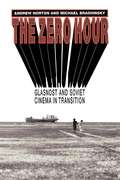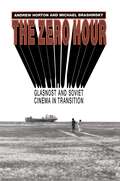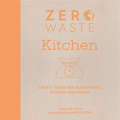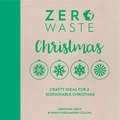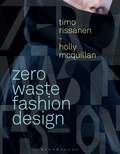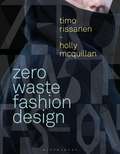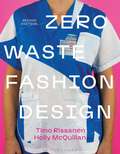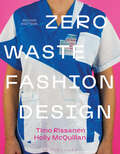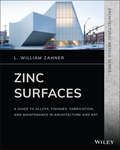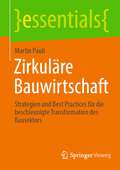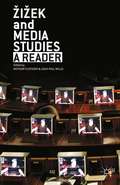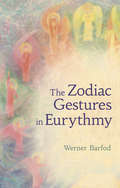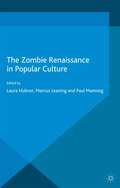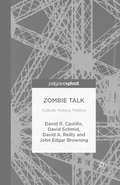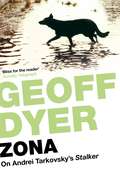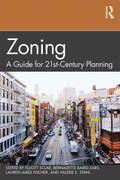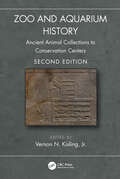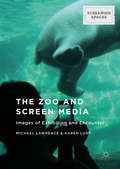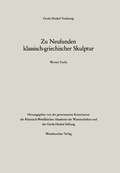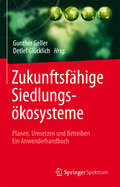- Table View
- List View
The Zero Hour: Glasnost and Soviet Cinema in Transition
by Andrew Horton Michael BrashinskyNow faced with the "zero hour" created by a new freedom of expression and the dramatic breakup of the Soviet Union, Soviet cinema has recently become one of the most interesting in the world, aesthetically as well as politically. How have Soviet filmmakers responded to the challenges of glasnost? To answer this question, the American film scholar Andrew Horton and the Soviet critic Michael Brashinsky offer the first book-length study of the rapid changes in Soviet cinema that have been taking place since 1985. What emerges from their collaborative dialogue is not only a valuable work of film criticism but also a fascinating study of contemporary Soviet culture in general. Horton and Brashinsky examine a wide variety of films from BOMZH (initials standing for homeless drifter) through Taxi Blues and the glasnost blockbuster Little Vera to the Latvian documentary Is It Easy to Be Young? and the "new wave" productions of the "Wild Kazakh boys." The authors argue that the medium that once served the Party became a major catalyst for the deconstruction of socialism, especially through documentary filmmaking. Special attention is paid to how filmmakers from 1985 through 1990 represent the newly "discovered" past of the pre-glasnost era and how they depict troubled youth and conflicts over the role of women in society. The book also emphasizes the evolving uses of comedy and satire and the incorporation of "genre film" techniques into a new popular cinema. An intriguing discussion of films of Georgia, Estonia, Latvia, Lithuania, and Kazakhstan ends the work.
The Zero Hour: Glasnost and Soviet Cinema in Transition
by Andrew Horton Michael BrashinskyNow faced with the "zero hour" created by a new freedom of expression and the dramatic breakup of the Soviet Union, Soviet cinema has recently become one of the most interesting in the world, aesthetically as well as politically. How have Soviet filmmakers responded to the challenges of glasnost? To answer this question, the American film scholar Andrew Horton and the Soviet critic Michael Brashinsky offer the first book-length study of the rapid changes in Soviet cinema that have been taking place since 1985. What emerges from their collaborative dialogue is not only a valuable work of film criticism but also a fascinating study of contemporary Soviet culture in general. Horton and Brashinsky examine a wide variety of films from BOMZH (initials standing for homeless drifter) through Taxi Blues and the glasnost blockbuster Little Vera to the Latvian documentary Is It Easy to Be Young? and the "new wave" productions of the "Wild Kazakh boys." The authors argue that the medium that once served the Party became a major catalyst for the deconstruction of socialism, especially through documentary filmmaking. Special attention is paid to how filmmakers from 1985 through 1990 represent the newly "discovered" past of the pre-glasnost era and how they depict troubled youth and conflicts over the role of women in society. The book also emphasizes the evolving uses of comedy and satire and the incorporation of "genre film" techniques into a new popular cinema. An intriguing discussion of films of Georgia, Estonia, Latvia, Lithuania, and Kazakhstan ends the work.
The Zero Hour: Glasnost and Soviet Cinema in Transition
by Andrew Horton Michael BrashinskyNow faced with the "zero hour" created by a new freedom of expression and the dramatic breakup of the Soviet Union, Soviet cinema has recently become one of the most interesting in the world, aesthetically as well as politically. How have Soviet filmmakers responded to the challenges of glasnost? To answer this question, the American film scholar Andrew Horton and the Soviet critic Michael Brashinsky offer the first book-length study of the rapid changes in Soviet cinema that have been taking place since 1985. What emerges from their collaborative dialogue is not only a valuable work of film criticism but also a fascinating study of contemporary Soviet culture in general. Horton and Brashinsky examine a wide variety of films from BOMZH (initials standing for homeless drifter) through Taxi Blues and the glasnost blockbuster Little Vera to the Latvian documentary Is It Easy to Be Young? and the "new wave" productions of the "Wild Kazakh boys." The authors argue that the medium that once served the Party became a major catalyst for the deconstruction of socialism, especially through documentary filmmaking. Special attention is paid to how filmmakers from 1985 through 1990 represent the newly "discovered" past of the pre-glasnost era and how they depict troubled youth and conflicts over the role of women in society. The book also emphasizes the evolving uses of comedy and satire and the incorporation of "genre film" techniques into a new popular cinema. An intriguing discussion of films of Georgia, Estonia, Latvia, Lithuania, and Kazakhstan ends the work.
Zero Waste: Crafty ideas for sustainable kitchen solutions (Zero Waste #2)
by Emma Friedlander-Collins Christine LeechTurn your kitchen into a waste-free zone with these crafty solutions for everything from 'unpaper' towels to reusable kitchen wipes and clever storage solutions. The zero waste movement is huge and this collection will help you to craft your own zero waste solutions - with just a few craft skills you will be able to turn your unwanted waste into storage and cleaning items for your kitchen. The kitchen is the heart of our homes and finding ways to make it feel healthy and wholesome are really important. From leftover food scraps to the endless packaging that our food comes in, there's so much that goes on in a kitchen and it's the place in our homes where we generate the mosts waste. Make your kitchen more sustainable with some clever craft ideas for reusing, upcycling and transforming waste. Whether you're a committed crafter or new to making, there is something for everyone no matter what your skill level is. Choose from projects and tutorials for the kitchen including sewing, crochet, patchwork, upcycling and reuse ideas. There are also some projects that require cutting, sticking and even drilling thrown in for good measure: learning how to do little bits of everything will give you a 'toolkit' to think creatively about how to reuse everyday things as you progress on your journey to zero waste living. Learn how to use up fabric scraps and old linen to create beeswax wraps for storing food; make your own paper caddy liners for food waste and create pots for growing kitchen herbs from empty bottles. Create a unique and practical apron from an old pair of thrifted curtains and sew some handy storage ideas for the family using pockets rescued from unwanted clothes. Upcycling and reuse gurus Emma Friedlander-Collins and Christine Leech show you how to turn your kitchen into a zero-waste zone with step-by-step instructions and some clever crafting. Packed full of original ideas, Zero Waste: Kitchen will help you to live the zero-waste way and improve your efforts to reduce, reuse and recycle while at the same time having fun.
Zero Waste: Crafty ideas for a sustainable Christmas (Zero Waste #3)
by Emma Friedlander-Collins Christine LeechCelebrate Christmas the zero-waste way with these crafty solutions for everything from Christmas tree decorations to advent calendars. The zero-waste movement is huge and this collection of crafty ideas will help you to create your own zero waste solutions for a sustainable Christmas. It’s time to reclaim Christmas - this collection is all about using the things around you to bring festive cheer to your home. It’s about crafting and creating together and using what you’ve got to make unique, unusual items that you can enjoy year after year. By crafting your zero-waste Christmas you are also creating memories – something that cannot be bought online. Upcycling and reuse gurus Emma Friedlander-Collins and Christine Leech show you how to turn Christmas into a zero-waste experience with step-by-step instructions and some clever crafting. Whether you’re a committed crafter or new to making, there is something for everyone no matter what your skill level is. Choose from projects and tutorials for a sustainable Christmas including sewing, crochet, upcycling and reuse ideas. You don’t need to have lots of craft skills to create these projects, there are step-by-step instructions for each one. There are also instructions for the basic craft techniques such as crochet and embroidery so you can get stuck in straightaway. There are four different Christmas themed chapters: Hot; Frosty; Skandi and Retro so you pick your favourite style or mix and match for festive mash-up! Projects include Coffee Cup Baubles; a minimalist wreath made using an old cake tin; a milk carton advent calendar and some magical fairy lights made using takeaway containers. Choose your favourite projects from this collection of 24 projects including no-waste decorations for the tree and zero-waste gift wrap. Packed full of original ideas, Zero Waste: Christmas will help you to celebrate the zero-waste way and improve your efforts to reduce, reuse and recycle while at the same time having fun.
Zero Waste Fashion Design (Required Reading Range)
by Timo Rissanen Holly McQuillanZero Waste Fashion Design combines research and practice to introduce a crucial sustainable fashion design approach.Written by two industry leading pioneers, Timo Rissanen and Holly McQuillan, the book offers flexible strategies and easy-to-master zero waste techniques to help you develop your own cutting edge fashion designs.Sample flat patterns and more than 20 exercises will reinforce your understanding of the zero waste fashion design process. Beautifully illustrated interviews with high-profile, innovative designers, including Winifred Aldrich, Rickard Lindqvist and Yeohlee Teng, show the stunning garments produced by zero waste fashion design.Featured topics include: The criteria for zero waste fashion design Manufacturing zero waste garments Adapting existing designs for zero waste Zero waste designing with digital technologies
Zero Waste Fashion Design (Required Reading Range Ser.)
by Timo Rissanen Holly McQuillanZero Waste Fashion Design combines research and practice to introduce a crucial sustainable fashion design approach.Written by two industry leading pioneers, Timo Rissanen and Holly McQuillan, the book offers flexible strategies and easy-to-master zero waste techniques to help you develop your own cutting edge fashion designs.Sample flat patterns and more than 20 exercises will reinforce your understanding of the zero waste fashion design process. Beautifully illustrated interviews with high-profile, innovative designers, including Winifred Aldrich, Rickard Lindqvist and Yeohlee Teng, show the stunning garments produced by zero waste fashion design.Featured topics include: The criteria for zero waste fashion design Manufacturing zero waste garments Adapting existing designs for zero waste Zero waste designing with digital technologies
Zero Waste Fashion Design (Required Reading Range Ser.)
by Timo Rissanen Holly McQuillanZero Waste Fashion Design combines practical examples, flat patterns and more than 20 exercises to help you incorporate this sustainable technique into your portfolio. There are also beautifully illustrated interviews with innovative designers, including Richard Lindgvist, Mary Beth Bentaha and Daniel Desanto to show how sustainable practice continues to evolve within industry.Industry pioneers, Timo Rissanen and Holly McQuillan, offer flexible strategies and easy-to-master zero waste techniques to help you develop your own cutting-edge fashion designs. This updated edition includes new content on integrating 3D design into a zero waste process, additional coverage of the historical context of zero waste around the world, and expands on the related technique of subtraction cutting to make this the ultimate practical guide to sustainable fashion design.
Zero Waste Fashion Design
by Timo Rissanen Holly McQuillanZero Waste Fashion Design combines practical examples, flat patterns and more than 20 exercises to help you incorporate this sustainable technique into your portfolio. There are also beautifully illustrated interviews with innovative designers, including Richard Lindgvist, Mary Beth Bentaha and Daniel Desanto to show how sustainable practice continues to evolve within industry.Industry pioneers, Timo Rissanen and Holly McQuillan, offer flexible strategies and easy-to-master zero waste techniques to help you develop your own cutting-edge fashion designs. This updated edition includes new content on integrating 3D design into a zero waste process, additional coverage of the historical context of zero waste around the world, and expands on the related technique of subtraction cutting to make this the ultimate practical guide to sustainable fashion design.
Zinc Surfaces: A Guide to Alloys, Finishes, Fabrication, and Maintenance in Architecture and Art (Architectural Metals Series)
by L. William ZahnerThe leading resource for architects, designers, and artists working with zinc Zinc Surfaces: A Guide to Alloys, Finishes, Fabrication and Maintenance in Architecture and Art combines the latest guidance and information about zinc surfaces into a single and comprehensive resource for architects and artists everywhere. The fifth book in the author’s authoritative Architectural Metals Series, Zinc Surfaces offers a highly visual, full-color guide to ensure architects and design professionals have the information they need to properly maintain and fabricate zinc surfaces. Numerous case studies illuminate and highlight the theoretical principles contained within. Full of concrete strategies and practical advice, Zinc Surfaces provides readers with complete information on topics including: The use of zinc in architecture The history of zinc’s use in design How to choose the right alloy for your purposes Surface and chemical finishes Corrosion resistance of various alloys This book is perfect for architecture professionals, metal fabricators and developers, architecture students and instructors, and designers and artists working with metals.
Zinc Surfaces: A Guide to Alloys, Finishes, Fabrication, and Maintenance in Architecture and Art (Architectural Metals Series)
by L. William ZahnerThe leading resource for architects, designers, and artists working with zinc Zinc Surfaces: A Guide to Alloys, Finishes, Fabrication and Maintenance in Architecture and Art combines the latest guidance and information about zinc surfaces into a single and comprehensive resource for architects and artists everywhere. The fifth book in the author’s authoritative Architectural Metals Series, Zinc Surfaces offers a highly visual, full-color guide to ensure architects and design professionals have the information they need to properly maintain and fabricate zinc surfaces. Numerous case studies illuminate and highlight the theoretical principles contained within. Full of concrete strategies and practical advice, Zinc Surfaces provides readers with complete information on topics including: The use of zinc in architecture The history of zinc’s use in design How to choose the right alloy for your purposes Surface and chemical finishes Corrosion resistance of various alloys This book is perfect for architecture professionals, metal fabricators and developers, architecture students and instructors, and designers and artists working with metals.
Zirkuläre Bauwirtschaft: Strategien und Best Practices für die beschleunigte Transformation des Bausektors (essentials)
by Martin PauliDieses Essential fasst prägnant zusammen, warum die Prinzipien der Kreislaufwirtschaft für die Bauwirtschaft im Kontext von Klimawandel und zunehmender Ressourcenknappheit unabdingbar sind. Es gibt Einblicke in Umsetzungsstrategien und Projektbeispiele, beleuchtet die elementaren Methoden zur Messbarkeit von sektorspezifischen CO2-Emissionen und wirft einen systemischen Blick auf die Wertschöpfungskette Bau sowie die Implikationen, Potenziale und Risiken der Umsetzung.
Zizek and Media Studies: A Reader
by Matthew Flisfeder Louis-Paul WillisFilm, media, and cultural theorists have long appealed to Lacanian theory in order to discern processes of subjectivization, representation, and ideological interpellation. Here, the contributors take up a Zizekian approach to studies of cinema and media, raising questions about power, ideology, sexual difference, and enjoyment.
The Zodiac Gestures in Eurythmy
by Werner BarfodEurythmy is an art form that makes sounds visible. By incorporating zodiac gestures into their art, as indicated by Rudolf Steiner, eurythmists can draw on a deep connection between the earth and the cosmos. The zodiac, as representative of the whole cosmos, is a vital part of human spirituality, acting as the backdrop to human life. But it can be hard to fathom the zodiac's secrets, even through meditation. Barfod draws a parallel between meditative exercises and eurythmy practice, and shows how zodiac gestures in eurythmy can reveal cosmic insights. This is a book for eurythmy teachers and practitioners who want to deepen their art and spiritual work.
The Zombie Renaissance in Popular Culture
by Paul Manning Laura Hubner Marcus LeaningThis collection addresses the significant cultural phenomenon of the 'zombie renaissance' – the growing importance of zombie texts and zombie cultural practices in popular culture. The chapters examine zombie culture across a range of media and practices including films games, music, social media, literature and fandom.
Zombie Talk: Culture, History, Politics
by John Edgar Browning David Schmid David Castillo David A. ReillyZombie Talk offers a concise, interdisciplinary introduction and deep analytical set of theoretical approaches to help readers understand the phenomenon of zombies in contemporary and modern culture. With essays that combine Humanities and Social Science methodologies, the authors examine the zombie through an array of cultural products from different periods and geographical locations: films ranging from White Zombie (1932) to the pioneering films of George Romero, television shows like AMC's The Walking Dead, to literary offerings such as Richard Matheson's I am Legend (1954) and Seth Grahame-Smith's Pride, Prejudice and Zombies (2009), among others.
Zombies in Western Culture: A Twenty-First Century Crisis
by John Vervaeke Filip Miscevic Christopher MastropietroWhy has the zombie become such a pervasive figure in twenty-first-century popular culture? John Vervaeke, Christopher Mastropietro and Filip Miscevic seek to answer this question by arguing that particular aspects of the zombie, common to a variety of media forms, reflect a crisis in modern Western culture. The authors examine the essential features of the zombie, including mindlessness, ugliness and homelessness, and argue that these reflect the outlook of the contemporary West and its attendant zeitgeists of anxiety, alienation, disconnection and disenfranchisement. They trace the relationship between zombies and the theme of secular apocalypse, demonstrating that the zombie draws its power from being a perversion of the Christian mythos of death and resurrection. Symbolic of a lost Christian worldview, the zombie represents a world that can no longer explain itself, nor provide us with instructions for how to live within it. The concept of 'domicide' or the destruction of home is developed to describe the modern crisis of meaning that the zombie both represents and reflects. This is illustrated using case studies including the relocation of the Anishinaabe of the Grassy Narrows First Nation, and the upheaval of population displacement in the Hellenistic period. Finally, the authors invoke and reformulate symbols of the four horseman of the apocalypse as rhetorical analogues to frame those aspects of contemporary collapse that elucidate the horror of the zombie. Zombies in Western Culture: A Twenty-First Century Crisis is required reading for anyone interested in the phenomenon of zombies in contemporary culture. It will also be of interest to an interdisciplinary audience including students and scholars of culture studies, semiotics, philosophy, religious studies, eschatology, anthropology, Jungian studies, and sociology.
Zona: A Book about a Film about a Journey to a Room
by Geoff DyerIn this spellbinding book, the man described by the Daily Telegraph as 'possibly the best living writer in Britain' takes on his biggest challenge yet: unlocking the film that has obsessed him all his adult life. Like the film Stalker itself, it confronts the most mysterious and enduring questions of life and how to live.
Zoning: A Guide for 21st-Century Planning
by Elliott Sclar Bernadette Baird-Zars Lauren Ames Fisher Valerie StahlZoning is at once a key technical competency of urban planning practice and a highly politicized regulatory tool. How this contradiction between the technical and political is resolved has wide-reaching implications for urban equity and sustainability, two key concerns of urban planning. Moving beyond critiques of zoning as a regulatory hindrance to local affordability or merely the rulebook that guides urban land use, this textbook takes an institutional approach to zoning, positioning its practice within the larger political, social and economic conflicts that shape local access for diverse groups across urban space. Foregrounding the historical-institutional setting in which zoning is embedded allows planners to more deeply engage with the equity and sustainability issues related to zoning practice. By approaching zoning from a social science and planning perspective, this text engages students of urban planning, policy and design with several key questions relevant to the realities of zoning and land regulation they encounter in practice. Why has the practice of zoning evolved as it has? How do social and economic institutions shape zoning in contemporary practice? How does zoning relate to the other competencies of planning, such as housing and transport? Where and why has zoning, an act of physical land use regulation, replaced social planning? These questions, grounded in examples and cases, will prompt readers to think critically about the potential and limitations of zoning. By re-forging the important links between zoning practice and the concerns of the urban planning profession, this text provides a new framework for considering zoning in the 21st century and beyond.
Zoning: A Guide for 21st-Century Planning
by Elliott Sclar Bernadette Baird-Zars Lauren Ames Fisher Valerie StahlZoning is at once a key technical competency of urban planning practice and a highly politicized regulatory tool. How this contradiction between the technical and political is resolved has wide-reaching implications for urban equity and sustainability, two key concerns of urban planning. Moving beyond critiques of zoning as a regulatory hindrance to local affordability or merely the rulebook that guides urban land use, this textbook takes an institutional approach to zoning, positioning its practice within the larger political, social and economic conflicts that shape local access for diverse groups across urban space. Foregrounding the historical-institutional setting in which zoning is embedded allows planners to more deeply engage with the equity and sustainability issues related to zoning practice. By approaching zoning from a social science and planning perspective, this text engages students of urban planning, policy and design with several key questions relevant to the realities of zoning and land regulation they encounter in practice. Why has the practice of zoning evolved as it has? How do social and economic institutions shape zoning in contemporary practice? How does zoning relate to the other competencies of planning, such as housing and transport? Where and why has zoning, an act of physical land use regulation, replaced social planning? These questions, grounded in examples and cases, will prompt readers to think critically about the potential and limitations of zoning. By re-forging the important links between zoning practice and the concerns of the urban planning profession, this text provides a new framework for considering zoning in the 21st century and beyond.
Zoo and Aquarium History: Ancient Animal Collections to Conservation Centers
by Vernon N. Kisling JrWild animals have been housed in zoos and aquariums for 5,000 years, fascinating people living in virtually every society. Today, these institutions are at a new milestone in their history. This second edition of Zoo and Aquarium History takes the reader on a journey through the transition of private collections to menageries, to zoos, then zoological gardens, and more recently conservation centers and sanctuaries. Under the direction of Vernon N. Kisling, an expert in zoo history, an international team of authors has thoroughly updated the only comprehensive, global history of animal collections, menageries, zoos, and aquariums. The resulting book documents the continuum of efforts in maintaining wild animal collections from ancient civilizations through today, explaining how modern zoos have developed their mission statements around the core aims of conservation, education, research and recreation. This new edition pulls together regional information, including new chapters on zoological gardens of Canada, Latin America, China, Israel, the Middle East, and New Zealand, along with the cultural aspects of each region to provide a foundation upon which further research can be based. It presents a chronological listing of the world's zoos and aquariums and features many never-before published photographs. Sidebars present supplementary information on pertinent personalities, events, and wildlife conservation issues. The original Appendix has been expanded to include over 1,200 zoos and aquariums, providing an invaluable resource. This is an extensive, chronological introduction to the subject, highlighting the published and archival resources for those who want to know more.
Zoo and Aquarium History: Ancient Animal Collections to Conservation Centers
by Vernon N. Kisling Jr.Wild animals have been housed in zoos and aquariums for 5,000 years, fascinating people living in virtually every society. Today, these institutions are at a new milestone in their history. This second edition of Zoo and Aquarium History takes the reader on a journey through the transition of private collections to menageries, to zoos, then zoological gardens, and more recently conservation centers and sanctuaries. Under the direction of Vernon N. Kisling, an expert in zoo history, an international team of authors has thoroughly updated the only comprehensive, global history of animal collections, menageries, zoos, and aquariums. The resulting book documents the continuum of efforts in maintaining wild animal collections from ancient civilizations through today, explaining how modern zoos have developed their mission statements around the core aims of conservation, education, research and recreation. This new edition pulls together regional information, including new chapters on zoological gardens of Canada, Latin America, China, Israel, the Middle East, and New Zealand, along with the cultural aspects of each region to provide a foundation upon which further research can be based. It presents a chronological listing of the world's zoos and aquariums and features many never-before published photographs. Sidebars present supplementary information on pertinent personalities, events, and wildlife conservation issues. The original Appendix has been expanded to include over 1,200 zoos and aquariums, providing an invaluable resource. This is an extensive, chronological introduction to the subject, highlighting the published and archival resources for those who want to know more.
The Zoo and Screen Media: Images of Exhibition and Encounter (Screening Spaces)
by Michael Lawrence Karen LuryThis book is the first critical anthology to examine the controversial history of the zoo by focusing on its close relationship with screen media histories and technologies. Individual chapters address the representation of zoological spaces in classical and contemporary Hollywood cinema, documentary and animation, amateur and avant-garde film, popular television and online media. The Zoo and Screen Media: Images of Exhibition and Encounter provides a new map of twentieth-century human-animal relations by exploring how the zoo, that modern apparatus for presenting living animals to human audiences, has itself been represented across a diverse range of moving image media.
Zukunftsfähige Siedlungsökosysteme: Planen, Umsetzen und Betreiben Ein Anwenderhandbuch
by Gunther Geller Detlef GlücklichDie gegenwärtige Menschheit und ihre Aktivitäten haben einen gewaltigen Einfluss auf das planetare Ökosystem, z.B. auf den Klimawandel und die Biodiversität. Die ländlichen und insbesondere die städtischen Siedlungen spielen dabei eine Hauptrolle. Die rasante Verstädterung geht ungebrochen weiter. Mehr als die Hälfte der Menschheit wohnt bereits in Städten. Wie können diese also nachhaltig gestaltet werden? Dazu soll dieses Handbuch einen Beitrag leisten.Die Autoren behandeln die Siedlungen in einem umfassenden Sinne als Ökosysteme. Diese sollen nach dem Vorbild reifer natürlicher Ökosysteme funktionieren und werden deshalb planmäßig so gestaltet, dass sowohl eine Symbiose der beiden Teilsysteme (technisch-kulturelles und natürliches) der Siedlung untereinander als auch mit den übergeordneten Systemen möglich wird. Dazu wird auch ein umfassendes Informations- und Qualitätsmanagement eingesetzt, das die bei Planungen übliche Prozess-Steuerung und Partizipation vertieft und erweitert. All dies kann Anwender und Betroffene bei der Planung und Gestaltung von nachhaltigen Siedlungs-Ökosystemen unterstützen.Das Handbuch verfolgt und vermittelt einen ganzheitlichen und integrativen Ansatz, der Fachgebiete wie Architektur und Städtebau, Landschaftsarchitektur und Grünplanung, Umweltschutz, Lebens- und Gesellschaftswissenschaften, Ökologie, Management usw. umfasst. Es behandelt Themen wie Energie-Einsparung, Kreisläufe und Wiederverwendung, nachwachsende Rohstoffe, Flächennutzung und Verkehr, sozio-kulturelle Rahmenbedingungen, wirkliche Partizipation, ganzheitliches Informations-, Stoff- und Qualitätsmanagement. Die Autoren erläutern das Gesamtkonzept , die Schritte der Umsetzung und stellen Werkzeuge für den Anwender bereit.
